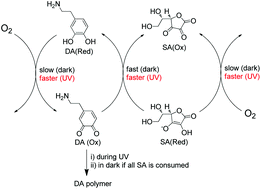Bio-inspired strategy for controlled dopamine polymerization in basic solutions†
Abstract
Polydopamine (PD) coatings, inspired by the adhesive behavior of the mussel foot, have attracted a lot of attention because of the simplicity, generalizability, and the capability for their secondary modification. However, many possible applications of PD coatings cannot be realized due to the difficulty in controlling dopamine polymerization under basic conditions. Here, we report a new method for the light-triggered control of both the onset and termination of dopamine polymerization under basic conditions. We demonstrate that dopamine polymerization in basic solutions can be efficiently inhibited by adding small quantities of sodium ascorbate (vitamin C) that reduces reactive dopamine quinone and delays dopamine polymerization. UV irradiation of this solution, however, leads to instantaneous dopamine polymerization, thereby making light-driven spatial and temporal control of dopamine polymerization under basic conditions possible. This method is inspired by the antioxidant role of vitamin C in the human body. The mechanism of the light-driven SA-controlled dopamine polymerization has been studied using spectroscopic and electroanalytical methods. By this new method we can control dopamine polymerization without changing the commonly used conditions for the formation of PD coatings, making this method compatible with all existing applications for PD coatings.



 Please wait while we load your content...
Please wait while we load your content...